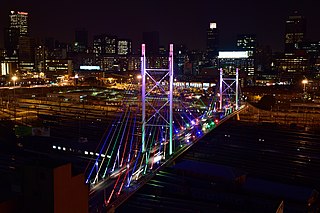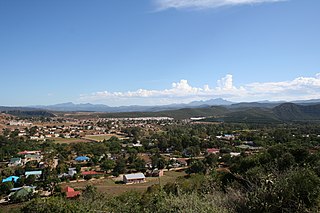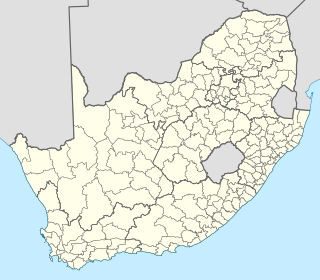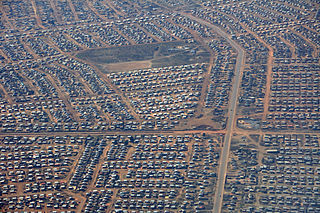
Soweto is a township of the City of Johannesburg Metropolitan Municipality in Gauteng, South Africa, bordering the city's mining belt in the south. Its name is an English syllabic abbreviation for South Western Townships. Formerly a separate municipality, it is now incorporated in the City of Johannesburg Metropolitan Municipality, and one of the suburbs of Johannesburg.

Johannesburg is the most populous city in South Africa with 4,803,262 people, and is classified as a megacity; it is one of the 100 largest urban areas in the world. It is the provincial capital and largest city of Gauteng, which is the wealthiest province in South Africa. Johannesburg is the seat of the Constitutional Court, the highest court in South Africa. Most of the major South African companies and banks have their head offices in Johannesburg. The city is located within the mineral-rich Witwatersrand hills, the epicentre of the international-scale mineral, gold and (specifically) diamond trade.

A slum is a highly populated urban residential area consisting of densely packed housing units of weak build quality and often associated with poverty. The infrastructure in slums is often deteriorated or incomplete, and they are primarily inhabited by impoverished people. Although slums are usually located in urban areas, in some countries they can be located in suburban areas where housing quality is low and living conditions are poor. While slums differ in size and other characteristics, most lack reliable sanitation services, supply of clean water, reliable electricity, law enforcement, and other basic services. Slum residences vary from shanty houses to professionally built dwellings which, because of poor-quality construction or lack of basic maintenance, have deteriorated.

In South Africa, the terms township and location usually refer to the often underdeveloped racially segregated urban areas that, from the late 19th century until the end of apartheid, were reserved for non-whites, namely Black Africans, Coloureds and Indians. Townships were usually built on the periphery of towns and cities. The term township also has a distinct legal meaning in South Africa's system of land title, which carries no racial connotations.
Alexandra, informally abbreviated to Alex, is a township in the Gauteng province of South Africa. It forms part of the City of Johannesburg Metropolitan Municipality and is located next to the wealthy suburb of Sandton. Alexandra is bounded by Wynberg on the west, Marlboro and Kelvin on the north, Kew, Lombardy West and Lombardy East on the south. Alexandra is one of the poorest urban areas in the country. Alexandra is situated on the banks of the Jukskei River. In addition to its original, reasonably well-built houses, it also has a large number of informal dwellings or "shacks" called imikhukhu.

Orange Farm ("Farma") is a township located approximately 45 km (28 mi) from Johannesburg in the Gauteng Province of South Africa. It is the southernmost township of the City of Johannesburg Metropolitan Municipality. Its name, a misnomer given that oranges are grown in orchards instead of farms, has Dutch origins. It is one of the youngest townships in South Africa, with the original inhabitants, laid-off farm workers, taking up residency in 1988. Support for the population came slowly mostly from people who were tenants at the larger township of Soweto.
Ennerdale is a town in the City of Johannesburg Metropolitan Municipality in Gauteng, South Africa. Ennerdale was declared as a coloured group area under the apartheid regime.

The suburbs of Johannesburg are officially demarcated areas within the City of Johannesburg Metropolitan Municipality, South Africa. As in other Commonwealth countries, the term suburb refers to a "neighbourhood", although in South Africa most "suburbs" have legally recognised borders and often separate postal codes. The municipal functions for the area, such as municipal policing and social services, are still managed by the city government.

Local government in South Africa consists of municipalities of various types. The largest metropolitan areas are governed by metropolitan municipalities, while the rest of the country is divided into counties called district municipalities, each of which consists of several boroughs called local municipalities. Since the boundary reform at the time of the municipal election of 3 August 2016 there are eight metropolitan municipalities, 44 district municipalities and 205 local municipalities.
Yeoville is an inner city neighbourhood of Johannesburg, in the province of Gauteng, South Africa. It is located in Region F. It is widely known and celebrated for its diverse, pan-African population but notorious for its high levels of crime and poverty.

The City of Johannesburg Metropolitan Municipality is a metropolitan municipality that manages the local governance of Johannesburg, the largest city in South Africa. It is divided into several branches and departments in order to expedite services for the city. Zulu is the most spoken home language at 23.4% followed by English at 20.1%.

The Jukskei River is one of the largest rivers in Johannesburg, South Africa. It is the southernmost river in the Crocodile River basin.

Thokoza, alternatively rendered Tokoza, is a township in Ekurhuleni, Gauteng. Thokoza is at the location of the now-defunct Palmietfontein Airport. It is situated south east of Alberton, adjacent to Katlehong. Thokoza was the first black township which was established in the South. During the early 1990s Thokoza was the middle of unrest between the supporters of the Inkatha Freedom Party (IFP), rival party of the African National Congress (ANC).
Reconstruction and Development Programme (RDP) was a South African socio-economic policy framework implemented by the African National Congress (ANC) government of Nelson Mandela in 1994 after months of discussions, consultations and negotiations between the ANC, its Alliance partners the Congress of South African Trade Unions and the South African Communist Party, and "mass organisations in the wider civil society".

Water supply and sanitation in South Africa is characterised by both achievements and challenges. After the end of Apartheid South Africa's newly elected government struggled with the then growing service and backlogs with respect to access to water supply and sanitation developed. The government thus made a strong commitment to high service standards and to high levels of investment subsidies to achieve those standards. Since then, the country has made some progress with regard to improving access to water supply: It reached universal access to an improved water source in urban areas, and in rural areas the share of those with access increased from 66% to 79% from 1990 to 2010.

Sibusiso Innocent Zikode is president of the South African shack dwellers' movement, which he co-founded with others in 2005. Abahlali baseMjondolo claims to have an audited paid up membership of over 115 000 across South Africa. His politics have been described as 'anti-capitalist'. According to the Mail & Guardian "Under his stewardship, ABM has made steady gains for housing rights."

The Hennops River is one of the larger rivers that drains Gauteng, South Africa. It has its source near Kempton Park, east of Johannesburg and meets the Crocodile River shortly before Hartbeespoort Dam. It is one of Gauteng's most polluted rivers.
South Africa has been dubbed "the protest capital of the world", with one of the highest rates of public protests in the world.
Fire is a serious hazard in shack settlements in South Africa. It has been argued that "On average in South Africa over the last five years there are ten shack fires a day with someone dying in a shack fire every other day." In 2011, 151 were reported to have been killed in shack fires in Cape Town. It was reported that in 2014, 2,090 people burned to death in the Gauteng province, "many of them in shack fires that sweep through informal settlements".
Machwene Rosina Semenya is a South African politician who has been the Chairperson of the Portfolio Committee on Human Settlements since 2021. A member of the African National Congress, she had previously served as the Chairperson of the Portfolio Committee on Agriculture, Forestry and Fisheries from 2014 to 2019 and as the Chairperson of the Portfolio Committee on Human Settlements, Water and Sanitation from 2019 to 2021. Semenya has been a Member of Parliament since 2014.















